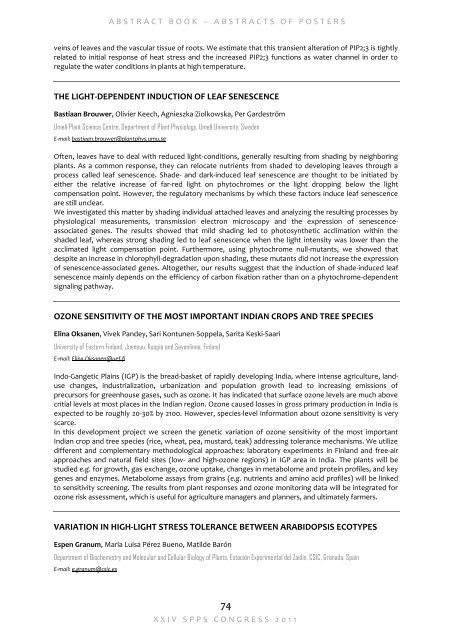1. Front Cover.cdr - CORE
1. Front Cover.cdr - CORE
1. Front Cover.cdr - CORE
Create successful ePaper yourself
Turn your PDF publications into a flip-book with our unique Google optimized e-Paper software.
A B S T R A C T B O O K – A B S T R A C T S O F P O S T E R S<br />
veins of leaves and the vascular tissue of roots. We estimate that this transient alteration of PIP2;3 is tightly<br />
related to initial response of heat stress and the increased PIP2;3 functions as water channel in order to<br />
regulate the water conditions in plants at high temperature.<br />
THE LIGHT-DEPENDENT INDUCTION OF LEAF SENESCENCE<br />
Bastiaan Brouwer, Olivier Keech, Agnieszka Ziolkowska, Per Gardeström<br />
Umeå Plant Science Centre, Department of Plant Physiology, Umeå University, Sweden<br />
E-mail: bastiaan.brouwer@plantphys.umu.se<br />
Often, leaves have to deal with reduced light-conditions, generally resulting from shading by neighboring<br />
plants. As a common response, they can relocate nutrients from shaded to developing leaves through a<br />
process called leaf senescence. Shade- and dark-induced leaf senescence are thought to be initiated by<br />
either the relative increase of far-red light on phytochromes or the light dropping below the light<br />
compensation point. However, the regulatory mechanisms by which these factors induce leaf senescence<br />
are still unclear.<br />
We investigated this matter by shading individual attached leaves and analyzing the resulting processes by<br />
physiological measurements, transmission electron microscopy and the expression of senescenceassociated<br />
genes. The results showed that mild shading led to photosynthetic acclimation within the<br />
shaded leaf, whereas strong shading led to leaf senescence when the light intensity was lower than the<br />
acclimated light compensation point. Furthermore, using phytochrome null-mutants, we showed that<br />
despite an increase in chlorophyll-degradation upon shading, these mutants did not increase the expression<br />
of senescence-associated genes. Altogether, our results suggest that the induction of shade-induced leaf<br />
senescence mainly depends on the efficiency of carbon fixation rather than on a phytochrome-dependent<br />
signaling pathway.<br />
OZONE SENSITIVITY OF THE MOST IMPORTANT INDIAN CROPS AND TREE SPECIES<br />
Elina Oksanen, Vivek Pandey, Sari Kontunen-Soppela, Sarita Keski-Saari<br />
University of Eastern Finland, Joensuu, Kuopio and Savonlinna, Finland<br />
E-mail: Elina.Oksanen@uef.fi<br />
Indo-Gangetic Plains (IGP) is the bread-basket of rapidly developing India, where intense agriculture, landuse<br />
changes, industrialization, urbanization and population growth lead to increasing emissions of<br />
precursors for greenhouse gases, such as ozone. It has indicated that surface ozone levels are much above<br />
critial levels at most places in the Indian region. Ozone caused losses in gross primary production in India is<br />
expected to be roughly 20-30% by 2100. However, species-level information about ozone sensitivity is very<br />
scarce.<br />
In this development project we screen the genetic variation of ozone sensitivity of the most important<br />
Indian crop and tree species (rice, wheat, pea, mustard, teak) addressing tolerance mechanisms. We utilize<br />
different and complementary methodological approaches: laboratory experiments in Finland and free-air<br />
approaches and natural field sites (low- and high-ozone regions) in IGP area in India. The plants will be<br />
studied e.g. for growth, gas exchange, ozone uptake, changes in metabolome and protein profiles, and key<br />
genes and enzymes. Metabolome assays from grains (e.g. nutrients and amino acid profiles) will be linked<br />
to sensitivity screening. The results from plant responses and ozone monitoring data will be integrated for<br />
ozone risk assessment, which is useful for agriculture managers and planners, and ultimately farmers.<br />
VARIATION IN HIGH-LIGHT STRESS TOLERANCE BETWEEN ARABIDOPSIS ECOTYPES<br />
Espen Granum, Maria Luisa Pérez Bueno, Matilde Barón<br />
Department of Biochemistry and Molecular and Cellular Biology of Plants, Estación Experimental del Zaidín, CSIC, Granada, Spain<br />
E-mail: e.granum@csic.es<br />
74<br />
X X I V S P P S C O N G R E S S 2 0 1 1


